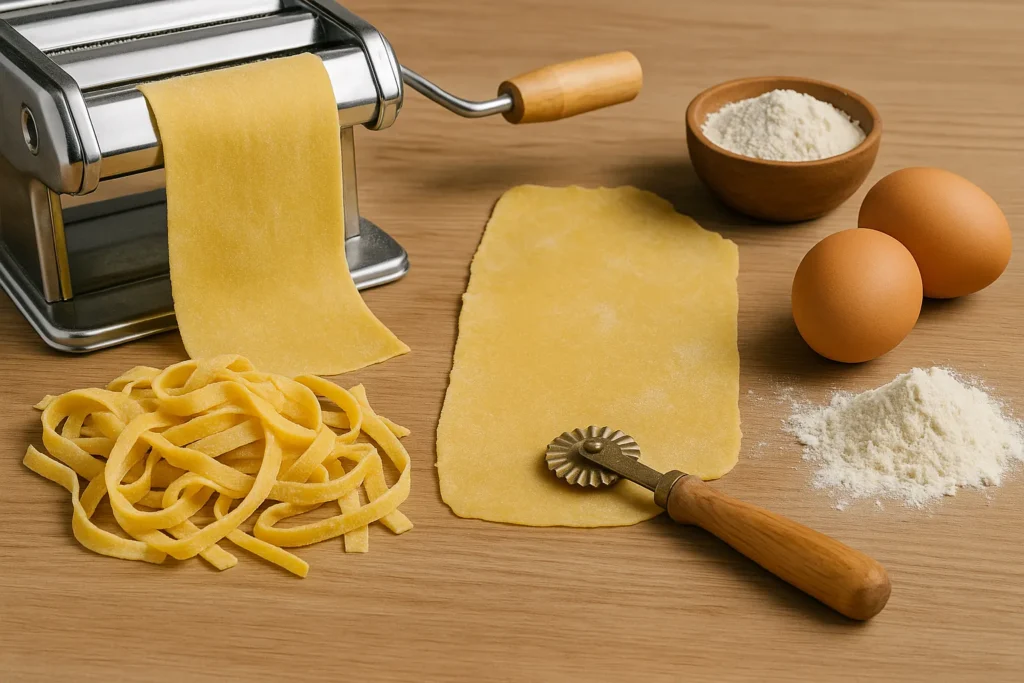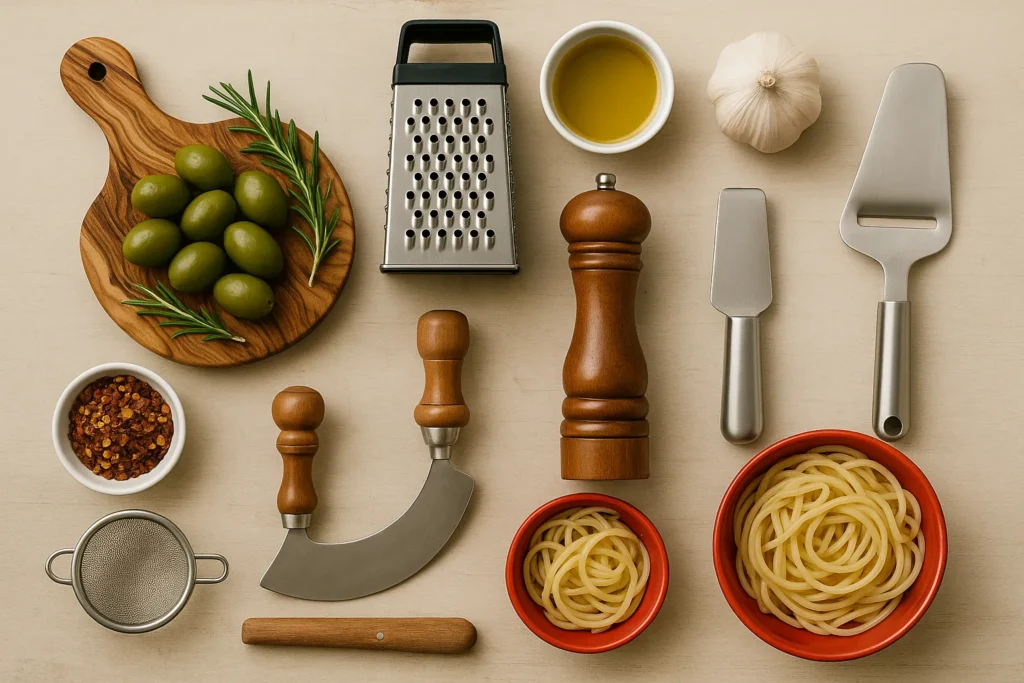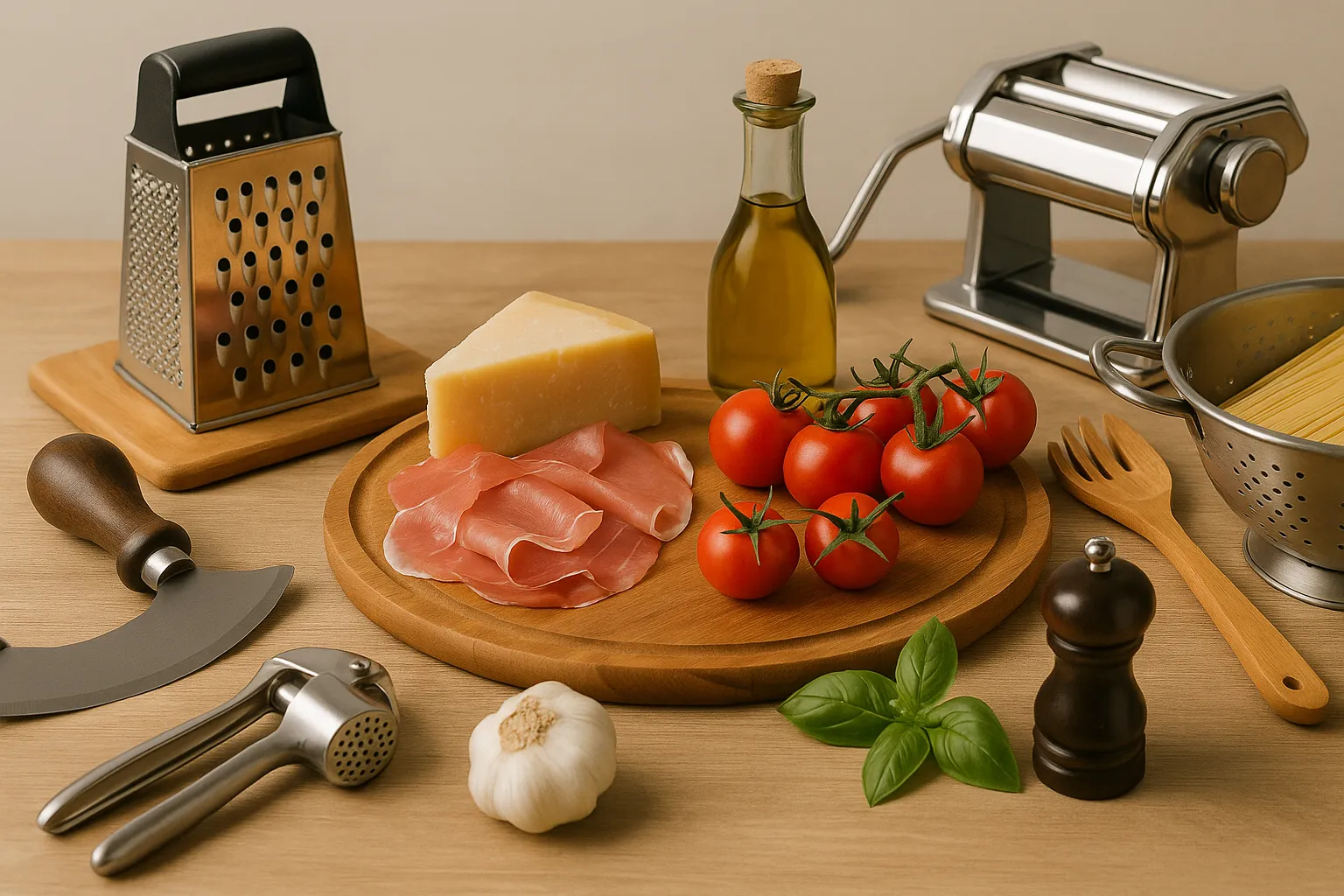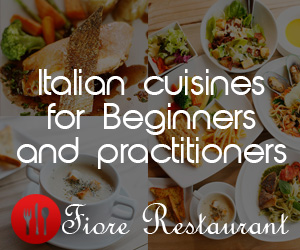Making something as simple as pasta can feel hard if you don’t have the right setup. The dough sticks. The pot overflows. Things burn. And instead of enjoying the process, you get stuck fixing problems.
Good Italian kitchen tools remove those problems before they start. They’re designed to handle heat, hold up over time, and make tasks like chopping, stirring, and lifting easier on your hands. When the basics work well, cooking becomes smoother and more rewarding.
In this article, you’ll learn which tools Italian home cooks reach for first and how each one fits into the flow of everyday food prep. You’ll also get simple tips to make your kitchen work better with fewer steps.
Ready to make cooking feel easier, not harder? Let’s get started.
Must-Have Tools in Every Italian Kitchen
Italian kitchens aren’t filled with gadgets. They rely on tools that do the job well and last for years. Over time, these items become part of your cooking rhythm: simple to reach for, easy to trust.

Here are a few worth having on your counter or in the top drawer:
Mezzaluna
This curved, two-handled knife is built for speed and control. You rock it back and forth to chop herbs, soften cooked meat, or even prep vegetables for soups and sauces. Based on our hands-on experience, a mezzaluna cuts more evenly than a standard knife and reduces strain on your wrist. It’s a great piece if you prep herbs often or want neater, faster cuts.
Mortar and pestle
A staple in Italian kitchens, this tool helps you grind garlic, spices, and herbs into smooth, flavourful pastes. Our testing shows that a good mortar breaks down ingredients more thoroughly than a food processor and gives you more control over the texture. Use it for pesto, rubs, or seasoning blends that bring out the best in your dishes.
Garlic press
If you cook with garlic a few times a week, this tool pays for itself fast. It lets you press cloves directly into the pan without peeling or chopping. After trying multiple designs, we’ve found presses with soft grip handles and sturdy metal construction work best. They save prep time and keep your fingers clean.
Wooden spoon
There’s a reason this tool shows up in every Italian kitchen. It’s safe for non-stick pans, easy to clean, and strong enough to stir thick sauces without bending. A spoon with a flat back and comfortable handle makes a difference during long cooking sessions.
A few high-quality tools can improve your kitchen without raising the price of every meal. These pieces support better results, make your work easier, and help you enjoy the process more.
The Tools That Make Fresh Pasta Possible
Making fresh pasta at home can feel like guesswork without the right setup. These four tools help you roll, shape, and portion dough with less effort and better results.

- Rolling pin: A long, straight rolling pin gives you better control when flattening dough. Unlike thicker Western pins, this Italian version lets your hands guide the shape and pressure. Based on our firsthand experience, the longer design is easier to steer and reduces the chance of tearing. It works especially well when you’re making fettuccine or stretching sheets for ravioli.
- Wooden board: A large wooden board, or spianatoia, gives you room to knead, shape, and rest your dough without sliding around. The surface grips flour well and keeps your ingredients in place. We’ve used boards made from pine and beech. Both hold up over time and stay stable during use.
- Pasta machine: A pasta machine helps you roll out smooth, even sheets of dough. Look for stainless steel rollers and adjustable thickness settings, because they’re reliable and easy to clean. Our research shows that newer machines clamp more securely and take less effort to use. In homes across Italy, pasta machines are a staple for shaping lasagna sheets, long strands like fettuccine, and filled pasta. It’s no surprise Italy leads the world in pasta production, with over 3.9 million metric tons made in 2023, according to Statista.
- Dough cutter: This small blade helps divide dough, scrape your board, and lift sticky pieces without tearing. After testing it ourselves, we’ve found it speeds up cleanup and helps shape cleaner edges. Choose one with a curved handle and a firm edge for the best control.
Each tool supports one step in the pasta-making process. Together, they make the work faster, smoother, and more satisfying.
More Kitchen Tools Italians Rely On Every Day
Italian kitchens don’t rely on high-tech gadgets. The most trusted tools are the ones that make everyday cooking feel easier. You’ll find these same items across homes because they’ve proven their worth over time.

Based on our experience, these tools often stay in use for decades:
- Terracotta pot – Holds heat evenly for slow-cooked stews. Great for braised meat or beans. You can bring it straight from the stovetop to the table, and it keeps food warm longer.
- Enamel tray – Moves from oven to table without needing another dish. It’s ideal for baked pasta, roasted vegetables, or even pies. The smooth surface also makes cleanup simple.
- Olive oil can – Helps pour just enough without spills. The narrow spout gives you control during prep or finishing. For example, drizzling olive oil over bruschetta is easier with a can than from a full bottle.
Many of these pieces are built to carry weight, handle high heat, and clean up without hassle. A good ladle should feel balanced in your hand. A well-placed colander drains pasta quickly and stays firm in the sink.
They may not cost much, but they improve how your kitchen runs and how your food turns out. And if you’re picking up any of them, look for versions made from stainless steel. That’s where we’re headed next.
Stainless Steel: A Modern Essential
Stainless steel tools show up in nearly every Italian kitchen for a reason. They stand up to heat, don’t rust, and handle daily cooking without wearing out. If you want tools that last, clean easily, and stay safe to use, stainless is a smart pick.
In our experience, they’re more reliable than wood or plastic, especially if you’re using the dishwasher or cooking often.
Here’s why stainless steel is worth it:
- Pasta machines: Alex bought a cheap pasta machine to save money, but the rollers jammed after a few uses, and the clamp kept slipping. Stainless steel versions roll dough smoothly, hold their settings, and don’t bend under pressure. They also resist moisture and flour buildup, making them easier to clean after a full batch of fettuccine or lasagna sheets.
- Colanders: Plastic colanders can trap odours and sometimes warp if used to drain hot pasta or boiled vegetables. A stainless steel colander holds its shape, stays stable in the sink, and drains quickly without clinging to food. It’s dishwasher-safe and dries fast, so you can rinse, shake, and hang it up without thinking twice.
- Ladles and tongs: If you’ve ever had a ladle with a loose handle or soft grip, you know how frustrating it is. Stainless steel options are strong enough to stir thick sauces, lift meat from the pot, or plate food without bending. They don’t absorb flavours, and the solid handles feel more secure during longer cooking sessions.
- Baking trays: Lower-cost trays often warp in the oven, especially under high heat or with uneven batter. Stainless steel trays hold their shape, heat evenly, and don’t flake or rust after washing. They’re safe for repeated baking and can handle everything from garlic bread to roasted vegetables. You can also run them through the dishwasher without worry.
These tools may cost a bit more at first, but the price pays off when they last for years without losing performance.
Start Your Collection with These First Tools
If you’re setting up your kitchen for Italian cooking, start with a few essential tools that support a variety of dishes. These aren’t just useful for pasta. They’ll serve you well whether you’re baking, roasting, or prepping everyday meals. In our experience, these tools give you more control and better results from the start.

Here’s a smart first order to consider:
- Cheese grater: A reliable grater handles more than parmesan. Use it for garlic, lemon zest, nutmeg, or even chocolate. Box graters offer more flexibility. Handheld models are easier to clean. Choose one with a firm grip and sharp blades. Your sauces and salads will taste fresher with properly grated ingredients.
- Colander: Useful for draining pasta, rinsing vegetables, or cleaning fresh herbs. Stainless steel versions last longer, hold their shape, and dry fast. If you cook frequently, it’s worth getting a size that fits securely in your sink and can handle full pots of food without wobbling or tipping over.
- Oil can: A narrow-spout olive oil can gives you better control during prep. You can drizzle lightly over salads, swirl into soups, or coat a pan evenly. Plastic squeeze bottles often split or clog. A good oil can make cooking smoother and cleanup easier.
- Ladle: It’s more than a soup spoon. A ladle helps you serve stews, pour sauces, or scoop pasta water with control. Look for one that feels balanced in your hand and can handle both thick and thin liquids without dripping. It’s one of those tools that ends up on the bench more often than expected.
- Baking tray: Roast vegetables, toast bread, bake gnocchi, or heat up leftovers. A strong baking tray handles high heat without warping or flaking. If you plan to cook often, choose a stainless steel tray that can go from oven to dishwasher while holding its shape.
To see how the right tools support real cooking, take a look at what Fiore Restaurant has built. Their classes, meals, and daily routines all show how quality gear turns practice into progress.
Let The Tools Tell a Story
Every tool in your kitchen earns its place. Some are passed down through the family. Others are picked up after a recipe went wrong, and something better was needed. These items stick around because they help things run more smoothly.
In our experience, reliable tools make cooking less stressful. They keep prep simple and let you stay focused on the task instead of fixing problems as they come up.
You don’t need a large collection. Just a few pieces that work well, feel good in your hands, and match your cooking style. These tools do more than fill a drawer. They make the time you spend in the kitchen easier and more enjoyable.




